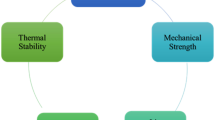Abstract
This study is intended to develop a polyindole-based polymer battery system which has a high electromotive force together with a high cycle property and is capable of fast charging and discharging. The battery includes poly(5-nitroindole) as the anode active material and polyaniline as the cathode active material. Sulfuric acid (40%) was used as the electrolytic solution with about 1.3-V electromotive force. The battery achieves about 79–65 mA h/g at charge and discharge current densities of 10–103 A/m2. As the theoretical capacity of poly(5-nitroindole) is 84 mA h/g, its capacity occurrence rate is 94% at a charge and discharge current density of 10 A/m2 with a very high reaction rate. In addition, the discharge capacity at a charge and discharge current density of 103 A/m2 maintains 82% of the capacity relative to that at 10 A/m2. This indicates that this battery has excellent fast charge and discharge properties. The cycle life of the battery, which is measured at a current density of 103 A/m2 with a discharge depth of 60% at 25°C, is about 32,000. This shows the battery system has an excellent cycle property. Moreover, the discarded battery will do little harm to the environment because it is free of heavy metals. In summary, this polyindole-based polymer battery system would be promising in future applications such as a hybrid electric vehicle with the development of the battery system.
Similar content being viewed by others
References
K. Naoi, H. Sakai, S. Ogano and T. Osaka, J. Power Sources, 237, 20 (1987).
R. H. Burroughes, C. A. Jones and R. H. Friend, Nature, 137, 335 (1988).
P. S. Gustafasson, Y. Cao, G. M. Treacy, F. Klavetter, N. Colaneri and A. J. Heeger, Nature, 477, 357 (1992).
H. S. White, G. P. Kittelson and M. S. Wrighton, J. Am. Chem. Soc., 106, 5375 (1984).
P. N. Bartlett and J. J. Farrington, Bull. Electrochem., 208, 8 (1992).
T. A. Skochim, Handbook of Conducting Polymers, Dekker, New York, 1986.
G. Tourillon and F. Garnier, J. Electroanal. Chem., 135, 173 (1982).
R. Waltman, A. Diaz and J. Bargon, J. Phys. Chem., 88, 4343 (1984).
P. N. Bartlett and J. J. Farrington, J. Electroanal. Chem., 261, 471 (1989).
P. Novak, K. Muller, K. S. V. Santhanam and O. Haas, Chem. Rev., 97, 229 (1997).
P. C. Pandey and R. Prakash, J. Electrochem. Soc., 145, 999 (1998).
G. Kokkinidis and A. Kelaidopoulou, J. Electroanal. Chem., 197, 414 (1996).
Author information
Authors and Affiliations
Rights and permissions
About this article
Cite this article
Zhijiang, C. Study on a Novel Polymer-based Secondary Battery System. J Polym Res 13, 207–211 (2006). https://doi.org/10.1007/s10965-005-9027-5
Received:
Accepted:
Published:
Issue Date:
DOI: https://doi.org/10.1007/s10965-005-9027-5




